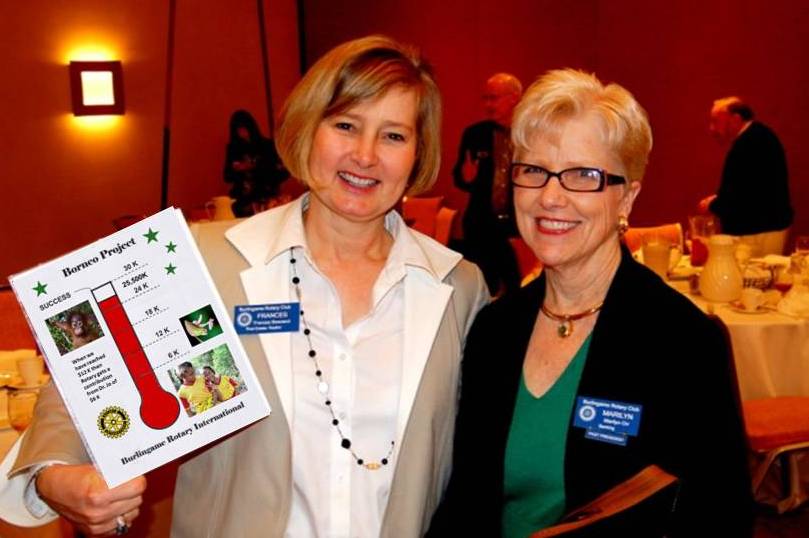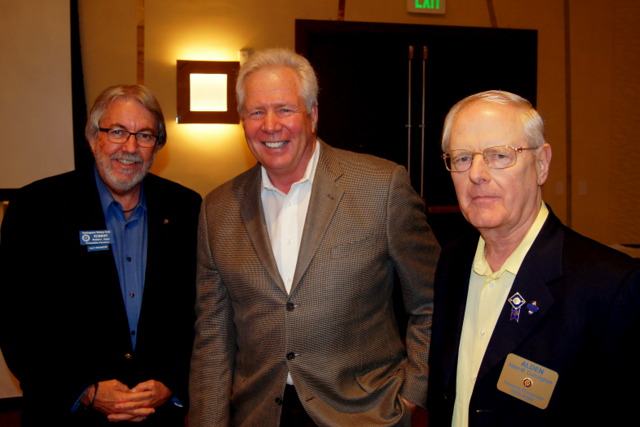High Gear for February 9, 2015 reported by Lage Andersen Feautring Dr. Greene
Posted by Scott Hartley
on Feb 09, 2015
Announcements:
- February Birthdays of Rotarians are: Robyn Lee on the 6th, Cheryl Fama on the 14th, and Rosemary Rayburn on the 23rd.
- February Birthdays of Spouses of Rotarians are: Lester Lee (Robyn’s husband) on the 6th, and Joyce Bouquet (Pierre’s wife) on the 15th.
- Wedding Anniversaries: Marylyn and Rich Orr are celebrating their 42nd anniversary this month.
- Joining Rotary Anniversaries: This month, Dr. Paul Nieberding celebrates his 49th year in Burlingame Rotary and Maggie MacIsaac celebrates her 1 year anniversary with our club.
- Joy Huetteman and Sean Williams reminded us that the Kentucky Derby party will be on May 2, 2015 from 1pm to 4pm (Further Derby Party details are in the attached PDF.) The cost is $75.00 per person. Joy and Sean quizzed the club on Derby related matters in a successful and entertaining effort to sell tickets and collect fines.

- Francis Boscacci, our Chair of International Service updated us on the Borneo Project. We have three weeks to go to get to the goal of $30,000 raised for the Borneo Project. So far we have raised over $25,000 dollars. Francis said that two other Rotary clubs, the Foster City club and a club in Montana have joined in to support the project.
Program and Speaker:
- Mike Horowitz introduced our Speaker, Dr. Warner Greene, a world class scientist and physician. Dr. Greene is;
- Founding Director and Nick and Sue Hellman Distinguished Professor of the Gladstone Institute of Virology and Immunology.
- Professor of Medicine, Micro-Biology and Immunology at UCSF Medical Center.
- Co-Director of the UCSF-Gladstone Research for Aids research, one of the 100 most cited scientist in the World and the Author of more than 300 scientific articles
- The President of the Accordia Global Health Institute located in Central Africa.
- A 2 handicap in golf.
- Dr. Greene received his BA at Stanford, his M.D. and PH.D at Washington University School of Medicine.
- Dr. Greene spoke to us on the Ebola outbreak. The latest Ebola outbreak was a hundred times worse than any previous outbreak, with over 22,0000 people infected and over 8,000 dead.
- The outbreak was in the Central African countries of Guinea, Sierra Leone, and Liberia. Mali, Nigeria, Senegal, Spain and the United States were also affected. The area where the outbreak took place had endured a long civil war resulting in great distrust of any government agencies and also a decimated health care system with only one doctor for every 100,000 persons.
- Since 1967 there have been five major outbreaks of Ebola, each causing the deaths of between 300 to 600 people. Prior to this outbreak, the 80 to 90% of the people infected with Ebola had died. In this latest outbreak, about 50% of the infected died. Dr. Greene speculated whether the less severe disease allowed the disease to spread more rapidly than in the past, because victims lived longer before dying, increasing the possibility of spreading the disease.
- The Ebola virus is one of six “Filoviruses” that include the Marburg virus, discovered in 1967, and five different strains of the Ebola virus, the first of which was discovered in 1976.
- The Ebola virus probably hides out in fruit bats in between outbreaks. Chimpanzees and gorillas also become victims of the Ebola virus. The Ebola virus is transmitted to humans as a result of handling and eating bats and also through “bush meat”, which is the smoked meat of Monkeys and Chimpanzees.
- After infection, the onset of symptoms is normally within 2 to 21 days with 4 to 10 days being the average. Victims normally die from the shock of the infection that causes their organs, particularly the kidneys and the liver, to shut down.
- There is no proven treatment for Ebola, but therapies have included antibodies monoclonal, antibodies grown on tobacco leaves and the infusion of plasma from surviving Ebola patients. There is work being done to develop vaccines.
- Dr. Greene compared the scale of Ebola to a couple of other diseases;
- More children die of measles every month than have ever died of Ebola
- Every 2 days more people die of AIDS than have ever died of Ebola.
- Dr. Greene summed up the lessons of the Ebola outbreak as follows:
- The outside world was 90 to 120 days too slow to respond to the epidemic.
- The U.S. was not sufficiently prepared.
- The CDEC gave overly confident information on the unlikelihood that Ebola could spread to the United States.
- We need better medicine and Ebola vaccines.
- Africa needs more mobile medical infrastructure to respond to treatment in different areas where an outbreak might arise.
- Since we are a global society, the Ebola virus could spread to anywhere in the World.

Next Week’s Program: No Meeting next week on February 16-Presidents Holiday.
Next Meeting Monday, February 23, 2015